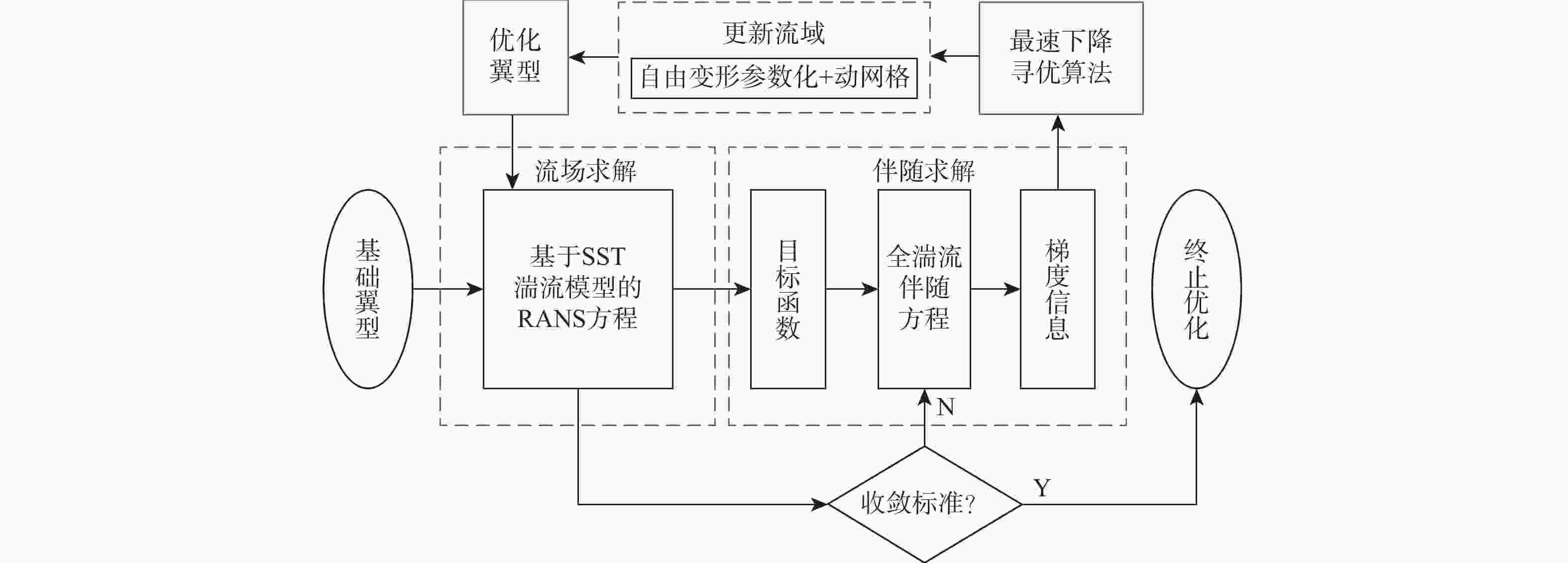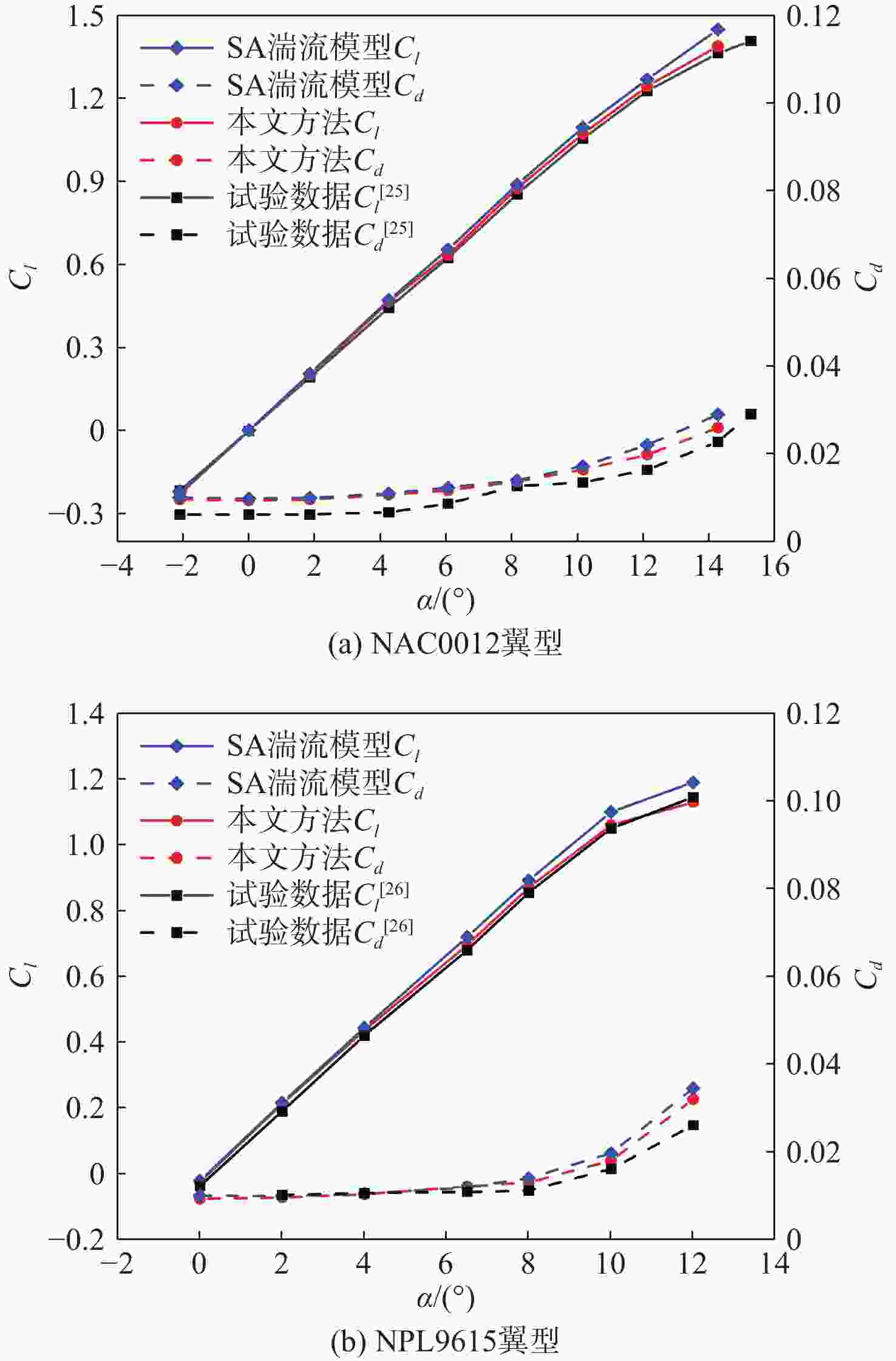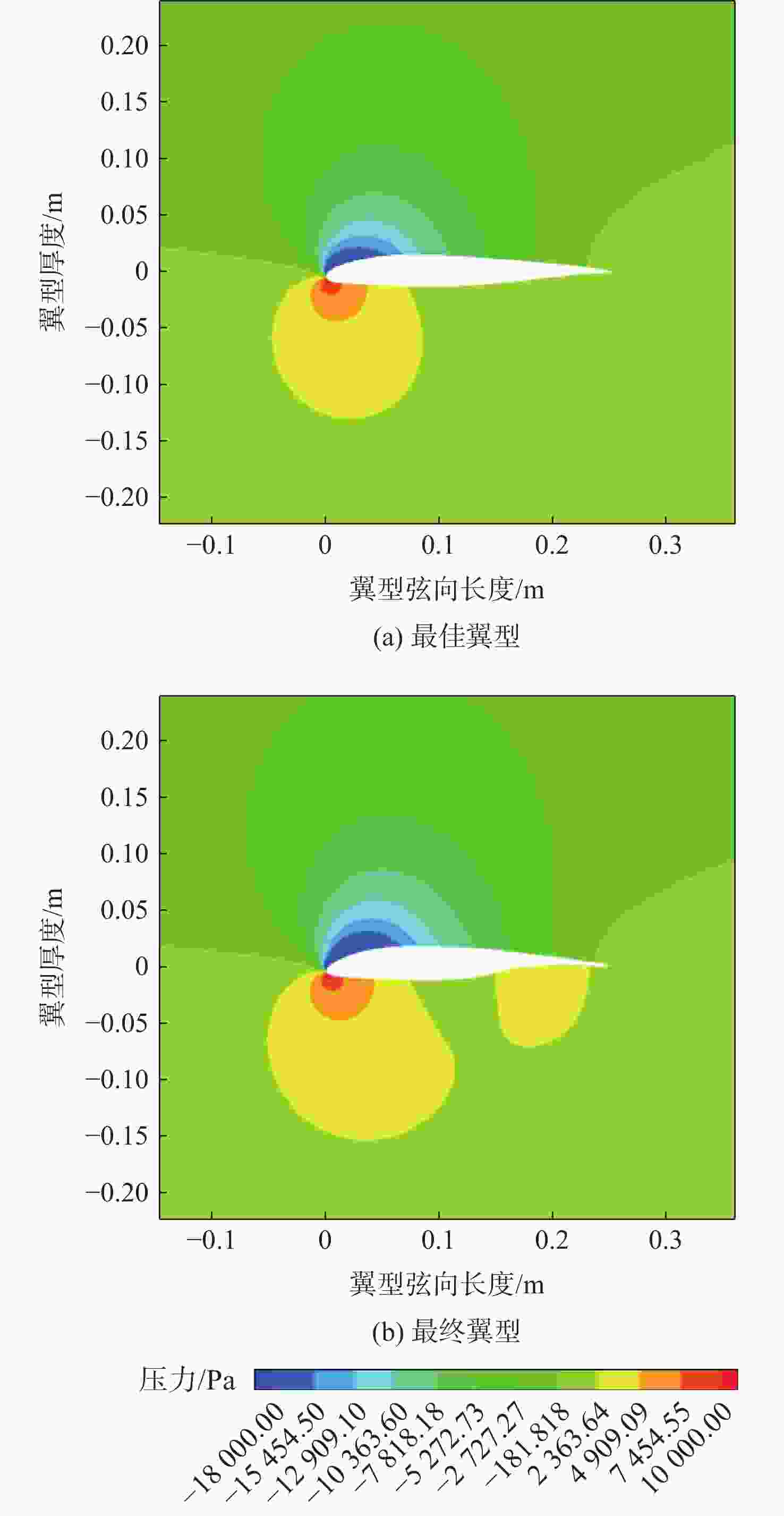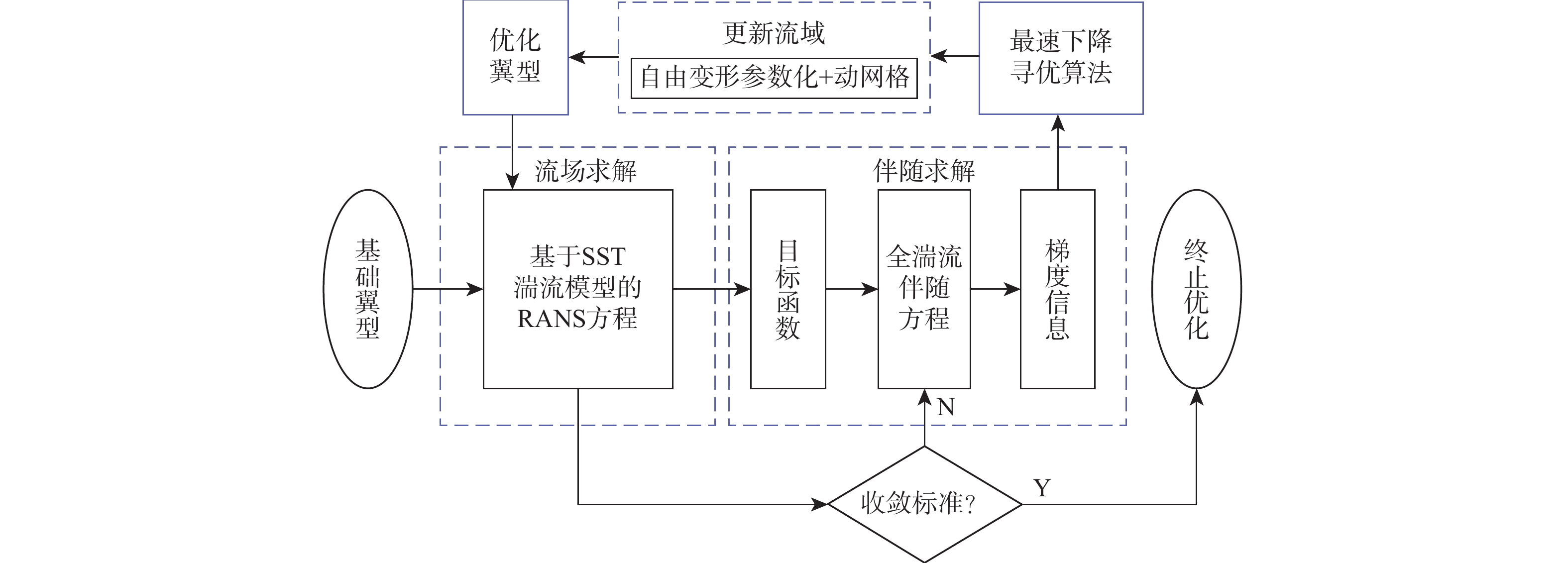-
摘要:
为解决当前翼型优化中广泛使用的冻结湍流黏性假设存在的固有缺陷和基于Spalart-Allmaras(S-A)全湍流伴随中湍流模型对气动力计算精度较差的问题,提出一套新的翼型优化方法,其耦合了全湍流连续伴随求解、剪切应力传递(SST)湍流模型封闭的雷诺平均Navier-Stokes (RANS) 方程、自由变形参数化方法和动网格变形技术。基于所提方法,在气动力系数相较于S-A模型有更高捕捉精度的基础上,对NPL9615翼型以最大升阻比为优化目标,并与冻结湍流黏性假设方法对比。结果表明:所提方法将原有翼型的升阻比提高了16.39%,而冻结湍流黏性假设方法获得最终翼型的升阻比仅提高了原有翼型的9.84%,说明所提方法在最优外形的获取上要领先于冻结湍流黏性假设,并且当翼型周围的湍流动能显著提高时,其优势愈发扩大。
Abstract:A new airfoil optimization method is proposed to address the inherent defects of the frozen eddy viscosity assumption widely used in airfoil optimization and the poor accuracy of aerodynamic calculation based on Spalart-Allmaras (S-A) adjoint turbulence model. This method couples the continuous adjoint turbulence solution, Reynolds-averaged Navier-Stokes(RANS) equations closed by shear stress transfer (SST) turbulence model, and free form deformation method with dynamic grid deformation technology. Based on the proposed method, the maximum lift to drag ratio is taken as the optimization objective for the NPL9615 airfoil, and compared with that of the method of the frozen eddy viscosity assumption. The results show that the optimized airfoil based on continuous SST adjoint turbulence method increases the lift to drag ratio of the original airfoil by 16.39%, while the frozen eddy viscosity assumption method increases the lift to drag ratio of the final airfoil only by 9.84%. This indicates that the proposed method is superior to the frozen eddy viscosity assumption in terms of optimization convergence. When the turbulent kinetic energy increases significantly, the advantage of the proposed model becomes more prominent.
-
表 1 收敛性测试的网格参数
Table 1. Mesh parameters of sensitivity test
网格编号 周向网格数目 法向网格数目 增长率 网格总数 G01 140 90 1.20 12188 G02 220 150 1.15 32404 G03 300 210 1.10 61270 表 2 G01、G02计算结果与G03的差异
Table 2. Difference of calculation results between G01, G02 and G03
网格编号 $\Delta C_l$/% $\Delta C_d$/% $ \alpha = 4{\text{°}} $ $\alpha = 12{\text{°}} $ $\alpha = 4{\text{°}}$/% $\alpha = 12{\text{°}}$/% G01与G03 −1.6 −2.3 2.7 5.1 G02与G03 −0.2 0.8 0.3 1.1 -
[1] 杨慧, 宋文萍, 韩忠华, 等. 旋翼翼型多目标多约束气动优化设计[J]. 航空学报, 2012, 33(7): 1218-1226.YANG H, SONG W P, HAN Z H, et al. Multi-objective and multi-constrained optimization design for a helicopter rotor airfoil[J]. Acta Aeronautica et Astronautica Sinica, 2012, 33(7): 1218-1226(in Chinese). [2] BAILLY J, BAILLY D. Multifidelity aerodynamic optimization of a helicopter rotor blade[J]. AIAA Journal, 2019, 57(8): 3132-3144. doi: 10.2514/1.J056513 [3] ALLEN L D, LIM J W, HAEHNEL R B, et al. Rotor blade design framework for airfoil shape optimization with performance considerations[C]//Proceedings of the AIAA Scitech 2021 Forum. Reston: AIAA, 2021. [4] TIMNAK N, JAHANGIRIAN A. Multi-point optimization of transonic airfoils using an enhanced genetic algorithm[J]. Proceedings of the Institution of Mechanical Engineers, Part G:Journal of Aerospace Engineering, 2018, 232(7): 1347-1360. doi: 10.1177/0954410017690549 [5] EBRAHIMI M, JAHANGIRIAN A. A hierarchical parallel strategy for aerodynamic shape optimization with genetic algorithm[J]. Scientia Iranica, Sharif University of Technology, 2015, 22(6): 2379-2388. [6] MARTINS J R R A, KROO I, ALONSO J. An automated method for sensitivity analysis using complex variables[C]//Proceedings of the 38th Aerospace Sciences Meeting and Exhibit. Reston: AIAA, 2000. [7] MARTINS J, STURDZA P, ALONSO J. The connection between the complex-step derivative approximation and algorithmic differentiation[C]//Proceedings of the 39th Aerospace Sciences Meeting and Exhibit. Reston: AIAA, 2001. [8] DAMM K A, GOLLAN R J, JACOBS P A, et al. Discrete adjoint optimization of a hypersonic inlet[J]. AIAA Journal, 2020, 58(6): 2621-2634. doi: 10.2514/1.J058913 [9] 雷锐午, 白俊强, 许丹阳, 等. 基于耦合伴随方法的串/并行气动结构优化设计对比[J]. 航空动力学报, 2019, 34(5): 1036-1049.LEI R W, BAI J Q, XU D Y, et al. Speciality assessment of sequential and concurrent aerostructural optimization based on coupled adjoint technique[J]. Journal of Aerospace Power, 2019, 34(5): 1036-1049(in Chinese). [10] 阮有钢, 刘战胜, 丰镇平. 基于伴随方法的叶片冷却通道导热优化研究[J]. 工程热物理学报, 2021, 42(6): 1431-1437.RUAN Y G, LIU Z S, FENG Z P. Study on adjoint-based conduction optimization method for blade internal cooling passages[J]. Journal of Engineering Thermophysics, 2021, 42(6): 1431-1437(in Chinese). [11] 曹杨, 张鹏飞, 丰镇平. 基于定涡黏性连续伴随的叶栅气热优化方法研究[J]. 工程热物理学报, 2019, 40(4): 789-796.CAO Y, ZHANG P F, FENG Z P. Study on continuous adjoint method for turbine cascade aerodynamic and heat transfer optimization design based on the constant eddy viscosity assumption[J]. Journal of Engineering Thermophysics, 2019, 40(4): 789-796(in Chinese). [12] LI J C, ZHANG M Q. Adjoint-free aerodynamic shape optimization of the common research model wing[J]. AIAA Journal, 2021, 59(6): 1990-2000. doi: 10.2514/1.J059921 [13] 田德, 吴志学, 罗涛, 等. 基于伴随方法的低风速风电机组翼型优化研究[J]. 太阳能学报, 2019, 40(7): 2064-2070.TIAN D, WU Z X, LUO T, et al. Optimization research on low wind speed wind turbine airfoil based on adjoint method[J]. Acta Energiae Solaris Sinica, 2019, 40(7): 2064-2070(in Chinese). [14] 罗佳奇, 杨婧. 基于伴随方法的单级低速压气机气动设计优化[J]. 航空学报, 2020, 41(5): 623368.LUO J Q, YANG J. Aerodynamic design optimization of a single low-speed compressor stage by an adjoint method[J]. Acta Aeronautica et Astronautica Sinica, 2020, 41(5): 623368(in Chinese). [15] LYU Z J, KENWAY G K, PAIGE C, et al. Automatic differentiation adjoint of the reynolds-averaged navier-stokes equations with a turbulence model[C]//Proceedings of the 21st AIAA Computational Fluid Dynamics Conference. Reston: AIAA, 2013. [16] 闫文辉, 薛然然. NACA4412翼型低速绕流数值计算中湍流模型对比[J]. 航空学报, 2017, 38(S1): 721515.YAN W H, XUE R R. Comparison of turbulence models for numerical simulation of low-speed flow around NACA4412 airfoil[J]. Acta Aeronautica et Astronautica Sinica, 2017, 38(S1): 721515 (in Chinese). [17] MENTER F, FERREIRA J C, ESCH T, et al. The SST turbulence model with improved wall treatment for heat transfer predictions in gas turbines[C]//Proceedings of the international gas turbine congress. Tokyo: Gas Turbine Society of Japan, 2003. [18] 于广元. 基于自由变形技术的伴随方法优化设计大曲率扩压通道[D]. 南京: 南京航空航天大学, 2014: 63-75.YU G Y. Aerodynamic design of large curvature diffuser channel by using adjoint method based on FFD technique[D]. Nanjing: Nanjing University of Aeronautics and Astronautics, 2014: 63-75 (in Chinese) . [19] OTHMER C, DE VILLIERS E, WELLER H. Implementation of a continuous adjoint for topology optimization of ducted flows[C]//Proceedings of the 18th AIAA Computational Fluid Dynamics Conference. Reston: AIAA, 2007. [20] 邵佳丰, 罗晨, 周怡君, 等. 基于自由变形技术的分流叶片形状优化设计[J]. 航空动力学报, 2021, 36(6): 1315-1323.SHAO J F, LUO C, ZHOU Y J, et al. Optimization design of splitter blade shape based on free form deformation technology[J]. Journal of Aerospace Power, 2021, 36(6): 1315-1323(in Chinese). [21] VURUSKAN A, HOSDER S. Impact of turbulence models and shape parameterization on robust aerodynamic shape optimization[J]. Journal of Aircraft, 2019, 56(3): 1099-1115. doi: 10.2514/1.C035039 [22] LI L, YUAN T Y, LI Y A, et al. Multidisciplinary design optimization based on parameterized free-form deformation for single turbine[J]. AIAA Journal, 2019, 57(5): 2075-2087. doi: 10.2514/1.J057819 [23] SEDERBERG T W, PARRY S R. Free-form deformation of solid geometric models[C]//Proceedings of the 13th Annual Conference on Computer Graphics and Interactive Techniques. New York: ACM, 1986: 151-160. [24] 张伟伟, 高传强, 叶正寅. 气动弹性计算中网格变形方法研究进展[J]. 航空学报, 2014, 35(2): 303-319.ZHANG W W, GAO C Q, YE Z Y. Research progress on mesh deformation method in computational aeroelasticity[J]. Acta Aeronautica et Astronautica Sinica, 2014, 35(2): 303-319(in Chinese). [25] LADSON C L. Effects of independent variation of Mach and Reynolds numbers on the low-speed aerodynamic characteristics of the NACA 0012 airfoil section[M]. Washington, D. C. : National Aeronautics and Space Administration, Scientific and Technical Information Division, 1988: 8-10. [26] GREGORY N, WILBY P G. NPL 9615 and NACA 0012 a comparison of aerodynamic data: ARC-CP-1261[R]. London: Her Majesty’s Stationery Office , 1973. -







 下载:
下载:
















